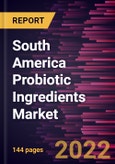The South America probiotic ingredients market is expected to grow from US$ 268.94 million in 2022 to US$ 438.17 million by 2028; it is estimated to grow at a CAGR of 8.5% from 2022 to 2028.
Antibiotics have been widely used as feed additives in livestock diets for several decades due to their therapeutic effects. However, a few countries have limited the use of certain antibiotics due to concerns that using antibiotics as feed additives contributes to increased bacterial antibiotic resistance. Moreover, probiotics, prebiotics, and essential oils have been suggested as antibiotic alternatives, as probiotics are live microbial feed supplements that beneficially affect the host by improving intestinal microbial balance. The use of probiotics as a possible alternative to antibiotics has received renewed interest due to the legislation prohibiting the use of subtherapeutic amounts of antibiotics. Probiotic is a generic term, and products can contain yeast cells, bacterial cultures, or both. These products stimulate the microorganisms capable of modifying the gastrointestinal environment to improve health and feed efficiency. They are known for boosting an animal's overall health by improving the microbial balance in its gut. The most used probiotic bacteria in animal feeds include lactobacillus, bacillus, streptococcus, pediococcus, enterococcus, bifidobacterium, and propionibacterium. In the last few years, the use of probiotic ingredients in the feed of farm animals such as pigs, poultry, and ruminants; aquaculture feeds; and pet feeds has increased significantly. Probiotics are increasingly introduced to commercial animal feed for cattle and poultry to change gastrointestinal flora and overall animal health.
With the new features and technologies, vendors can attract new customers and expand their footprints in emerging markets. This factor is likely to drive the South America probiotic ingredients market . The South Americaprobiotic ingredients market is expected to grow at a good CAGR during the forecast period.
Antibiotics have been widely used as feed additives in livestock diets for several decades due to their therapeutic effects. However, a few countries have limited the use of certain antibiotics due to concerns that using antibiotics as feed additives contributes to increased bacterial antibiotic resistance. Moreover, probiotics, prebiotics, and essential oils have been suggested as antibiotic alternatives, as probiotics are live microbial feed supplements that beneficially affect the host by improving intestinal microbial balance. The use of probiotics as a possible alternative to antibiotics has received renewed interest due to the legislation prohibiting the use of subtherapeutic amounts of antibiotics. Probiotic is a generic term, and products can contain yeast cells, bacterial cultures, or both. These products stimulate the microorganisms capable of modifying the gastrointestinal environment to improve health and feed efficiency. They are known for boosting an animal's overall health by improving the microbial balance in its gut. The most used probiotic bacteria in animal feeds include lactobacillus, bacillus, streptococcus, pediococcus, enterococcus, bifidobacterium, and propionibacterium. In the last few years, the use of probiotic ingredients in the feed of farm animals such as pigs, poultry, and ruminants; aquaculture feeds; and pet feeds has increased significantly. Probiotics are increasingly introduced to commercial animal feed for cattle and poultry to change gastrointestinal flora and overall animal health.
With the new features and technologies, vendors can attract new customers and expand their footprints in emerging markets. This factor is likely to drive the South America probiotic ingredients market . The South Americaprobiotic ingredients market is expected to grow at a good CAGR during the forecast period.
South America Probiotic Ingredients Market Segmentation
The South America probiotic ingredients market is segmented based on type, application, and country.- Based on type, the market is divided into lactobacillus, bifidobacterium, and others. The lactobacillus segment would dominate the South America probiotic ingredients market in 2022. In terms of application, the market is categorized into functional food & beverages, pharmaceuticals & nutraceuticals, animal feed, and others. The functional food & beverages segment would dominate the South America probiotic ingredients market in 2022.
- Based on country, the South America probiotic ingredients market is segmented into Brazil, Argentina, and the Rest of South America. The Rest of South America would dominate the South America probiotic ingredients market in 2022.
Table of Contents
1. Introduction
3. Research Methodology
4. SAM Probiotic Ingredients Market Landscape
5. SAM Probiotic Ingredients Market - Key Market Dynamics
6. Probiotic Ingredients - SAM Market Analysis
7. SAM Probiotic Ingredients Market Analysis - By Type
8. SAM Probiotic Ingredients Market Analysis - By Application
9. SAM Probiotic Ingredients Market - by Country Analysis
10. Industry Landscape
11. Company Profiles
12. Appendix
Companies Mentioned
- ADM
- Novozymes A/S
- Chr. Hansen Holding A/S
- Kerry Group plc
- Lallemand Inc
- IFF Nutrition & Biosciences
- AngelYeast Co., Ltd
- Probiotical S.p.A
- Adisseo
- Probi
Table Information
| Report Attribute | Details |
|---|---|
| No. of Pages | 144 |
| Published | September 2022 |
| Forecast Period | 2022 - 2028 |
| Estimated Market Value ( USD | $ 268.94 Million |
| Forecasted Market Value ( USD | $ 438.17 Million |
| Compound Annual Growth Rate | 8.5% |
| No. of Companies Mentioned | 10 |








